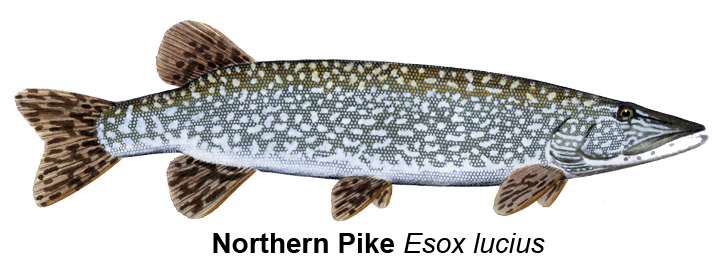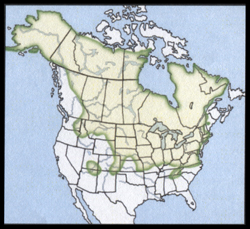Northern Pike, April 2013, Fish of the Month!
 Northern Pike
Northern Pike
Esox lucius
Local Names:
Common pike, Great Northern pike, Great Northern pickerel, Common pike, Jack, Jackfish, Snake
Average Size:
19 to 29 inches
2 to 10 pounds
Distinguishing Field Marks:
Color and color pattern are reliable distinguishing field marks for this species. (See the illustration.)
-
Typical of the pike family, Northern pike have very elongated bodies.
-
The snout is very long with a large mouth, although the upper jaw does not extend beyond the rear edge of the eye.
-
The eyes are set high on each side of the head.
-
The cheeks are completely scaled, while only the upper portions of the gill covers are.

-
There are usually 5 sensory pores on each side of the undersides of the lower jaws, although there may be as few as 3 or as many as 6, and all may be only on one side.
-
The body scales are small.
-
Both dorsal and anal fins are found well back on the body.
-
The pectoral and pelvic fins are set very low on the body.
-
The caudal fin is moderately forked.
-
All fins usually have dark wavy markings.
North American Range:
Map to the right shows approximate range in North America.
Diet:
Very young Northern pike feed on larger zooplankton for up to 10 days. At a length of 2 inches (5.0 cm.) they begin feeding on fish, although invertebrates continue to be present in their diets. As they gain in size, forage fish become their main source of food, but they supplement this with crayfish and frogs, young waterfowl, and small mammals.
Biology:
Like other members of their small family, Northern pike spawn in early spring, very soon after the ice is gone. They are fish of large rivers, ponds, and lakes, where they seek flooded margins and other heavily vegetated areas for spawning. The spawning period may last for only a few days. Northern pike spawning often takes place in very shallow water and usually occurs several times until all the eggs are spent and fertilized. Northern pike spawn in daylight, and release an average of 30,000 eggs per female. An extremely high early mortality rate insures that only a very small percentage of northern pike survive to adulthood.
Northern pike growth is quite rapid for the first several years of their lives, although these vary considerably according to the conditions in which they live. Once they have reached sexual maturity, usually 2 to 3 years for males and 3 to 4 years for females, growth tends to be in the form of increased weight rather than length. Northern pike may live 10 to 20 years. Those that grow more slowly are the longest lived.
The eggs and young fall prey to a range of predators including other fish - perch, minnows, and Northern pike - dragon fly larvae and other predatory nymphal insects, a variety of waterfowl, and aquatic mammals, such as muskrats. It is estimated that the infant mortality rate for northern pike may be as high as 99%.
Fly Fishing for Northern Pike:
As the accompanying range map shows, the Northern pike is very widely distributed over central and northern North American regions, where they can be found in a broad array of habitats. They tend to prefer large lakes, but can be found in rivers and smaller ponds. Their preferred habitat is around structure, either bottom or overhanging.
Spring and fall when the water is still cool will find Northern pike in the shallows. With warmer summer temperatures, they may still be found feeding in the shallows in early morning and again in late afternoon to evening, but keep in mind that all pikes are sight feeders, and are unlikely to feed after the sun has set or before it has risen. That said however, "Northerns" do feed well on overcast days as it would appear that these afford them some perceived protection.
Northern pike are most exciting on the take. Though not spectacular fighters, they do however make several strong runs seeking cover (do your best to keep a hooked pike out of weed-beds), occasional jumps, and are often some of the largest fish in any body of water where they are found.
Fly-fishing equipment for Northern pike should be in the mid-range, 8- to 9-weight. Northern pike often consume large forage fish, so large offerings are usually the order of the day. Streamer flies in 6 to 8 inch lengths and larger fly rod surface disturbing flies (poppers) are most likely to interest the larger pike. Floating lines with a heavy shock tippet to guard against the fish's many very sharp teeth are the order of the day for pike fly-rodding. The angler is well advised to remove difficult hooks from a pike with pliers rather than bare fingers.
On certain days, northern pike can be most cooperative, while on other days, they can seem to have disappeared from spots where they were found only a few days before. Persistence is a key word for pike fishing. It is the sportsman or woman who spends many days on a certain body of water who will learn through experience where the pike are to be found. For a thorough search of any large water, a boat is a necessity.
Significance to Humans:
As you might have inferred from the local names “snake” and “great northern pike,” different people have different opinions of this fish. In either case, the pike has been the basis for significant local commercial and sport fisheries. The commercial aspect of pike fishing is more widespread in Canada than in the U.S., while most of the fish are exported to the states. Pike are usually sold fresh or smoked.
The sport fishery for Northern pike has continued for generations alongside the commercial one.
I think of Northern pike as a great fly rod fish that is lots of fun to catch and release.
Status:
Seasonally plentiful and maintaining.






